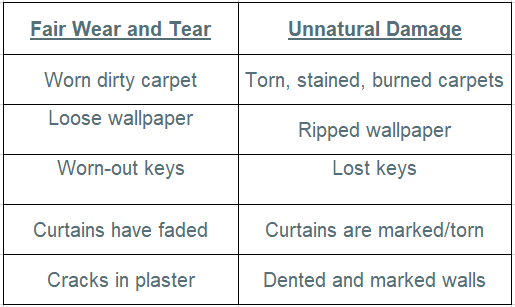What is ‘Fair Wear and Tear?
Wear and tear is a common feature of rental contracts, but what it actually means can be elusive. Finding out what fair wear and tear means is important for property managers and owners in order to understand what is legally correct when charging tenants for damages. There is a fine and definite difference between fair wear and tear and man-made property damage. By understanding the difference, it puts you in a good position in understanding your rights.
What constitutes wear and tear:
There isn’t a strict definition for the term, however it can be described as ‘the accumulated damage that happens through ordinary day-to-day use of the property.’ This is any damage that has been indirectly inflicted upon the property.
Each damage claim to a property needs to be assessed accordingly and a decision must be made:
- If it’s deemed as fair wear and tear, the owner needs to replace / sufficiently repair the item.
- If it’s deemed as damage, the tenant can be charged if necessary. The charge can vary from paying for a replacement or paying for complete repairs.
What doesn’t count as fair wear and tear:
Assessing how the damage claim has transpired is important in telling whether it is distressed or unnatural damage to the property.
If its clear damage has occurred gradually then it’s likely to be fair wear and tear. This contrasts to damages that seem as if they have come about quickly (e.g. smashes, tears, burns, bends)
The comparison of similar claims highlights what counts as fair wear and tear, and what doesn’t:
How to stay on top of this:
A property manager is entitled to receive their property in the same condition as they gave it to the tenant minus any fair wear and tear.
Protecting your property begins as soon as the tenancy starts, therefore it’s essential to do a full inventory check which is confirmed with the tenant the day tenancy starts. You can hire specialist companies to do an inventory with corresponding photos that are date stamped, and note the state of the items (better still, using a software like Kaptur makes this process significantly easier!). It’s important to stay on top of any damages throughout the tenancy so the property isn’t given back in sub-par condition.
It’s also advisable to keep record of any documentation that can assist you in validating the condition of the property. You should keep receipts as a guideline for how much replacements should cost (as charging a tenant for a newer more expensive product can be challenged). Receipts act as evidence if items in the inventory go missing come the end of the tenancy.
Lastly if work has been carried out by any third parties (e.g. workers /specialists / contractors) keep their reports and certificates as evidence of property condition. Conducting regular inspections to ensure the property is kept in a good state is also highly recommended, that way you can have a general idea of the state of the property and the furnishings.
Assessing damage to your property:
Naturally, the longer the tenancy the increased likelihood of genuine wear and tear claims from the tenant; which should be taken into consideration when assessing damage to your property whereby the property owner must absorb any damage costs.
However, assuming the initial inventory was completed competently, wear and tear claims soon after a tenancy starts should be investigated carefully.
Laws protecting tenants:
There are rules in place that protect the tenant from being exploited. Deposit money can only be taken for unpaid rent and damage to the property.
However, a tenant can still be charged for missing items, just not taken out of the deposit. You can only replace missing items with a like-for-like valued purchase, not replacing a missing or broken item with one of higher quality/value. The AST agreement should contain all arranged settlement between the two parties.
Conclusion:
It’s of vital importance to be knowledgeable about wear and tear so as if an issue comes up, you are well placed to take a decision. It can be difficult in deciding whether to absorb maintenance costs or be certain that the financial burden lies with the tenant, therefore knowing what constitutes as a fair claim will put you in good stead to avoid any unnecessary objection with tenants.



